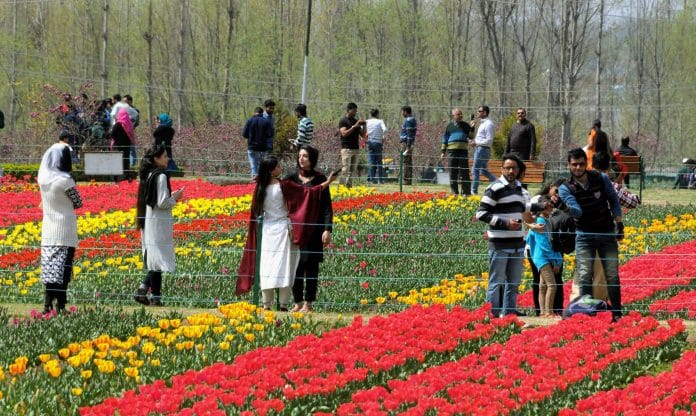One of Kashmir’s major tourist attractions, the 16-hectare garden is home to more than two million colourful tulips.
New Delhi: As spring unfolds in the Kashmir Valley, Srinagar’s famous Tulip Garden gets a new lease of life. This year is no exception with tourists from the rest of the country beginning to pour into the summer capital of Jammu and Kashmir to enjoy the breathtaking view of the 16-hectare garden overlooking the Dal Lake.
Indira Gandhi Memorial Tulip Garden is the largest tulip field in Asia and is situated in the Zabarwan foothills of Srinagar, at an altitude of 5,600 ft. One of Kashmir’s major tourist attractions, the garden is home to more than 2 million colourful tulips.
It was started as a ‘Model Floriculture Centre’ in 2007 by then J&K chief minister Ghulam Nabi Azad to promote tourism in the Valley.
The area of the garden is spread over 30 hectares and tulips occupy almost 16 hectares. The remaining area is covered by green spaces and other flowers like iris, hyacinths and daffodils. The garden has a three-unit landscape; the center of the garden is flat and ideal for the flowers while the slopes are lined with several fruit trees.
Why J&K suitable for tulips
The climate of Jammu & Kashmir is highly suitable for tulip production. Tulips are sown in temperatures as low as 15°Celsius. The flowers bloom when the temperature reaches close to 18 degrees Celsius.
Tulip Festival
The first ‘Tulip Festival’ was held last year. Over 40 different varieties of tulips were put on display and more than 1.75 lakh people visited the garden. The state governed earned a revenue of Rs 58 lakh.
The festival marks the beginning of the spring season in Kashmir, called Bahaar-e-Kashmir, in the month of March-April.
What is ‘Tulip Mania’?
The Netherlands, which is known as the tulip capital of the world, exports over 2 billion tulips annually. The production of tulips in the Netherlands occupies more than 10,000 hectares of the country’s land. The other large producers of tulips are Japan, France, Poland and New Zealand.
Tulips were originally found in countries like Turkey and Persia. They were grown in the royal gardens before being introduced to Western Europe.
In the 16th century, tulips were among the most expensive flowers. When the flower entered the Netherlands, its prices had gone up to 20 times its original rate and there was high purchase globally. Once the prices started crashing, the tulip producers went bankrupt, and this was termed as ‘Tulip mania’, the first major economic crisis in the world.
Meeting the demand
The tulip growers in Kashmir are trying to meet the growing demand of the flower. “There are many private entrepreneurs in Srinagar district but, right now we do not have enough cold storage facilities. We have markets in Delhi though,” said Sheikh Shabir Ahmed, district floriculture officer, Srinagar.
“Next year, we are planning to add new varieties of ornamental cherry trees to the garden,” he added.






